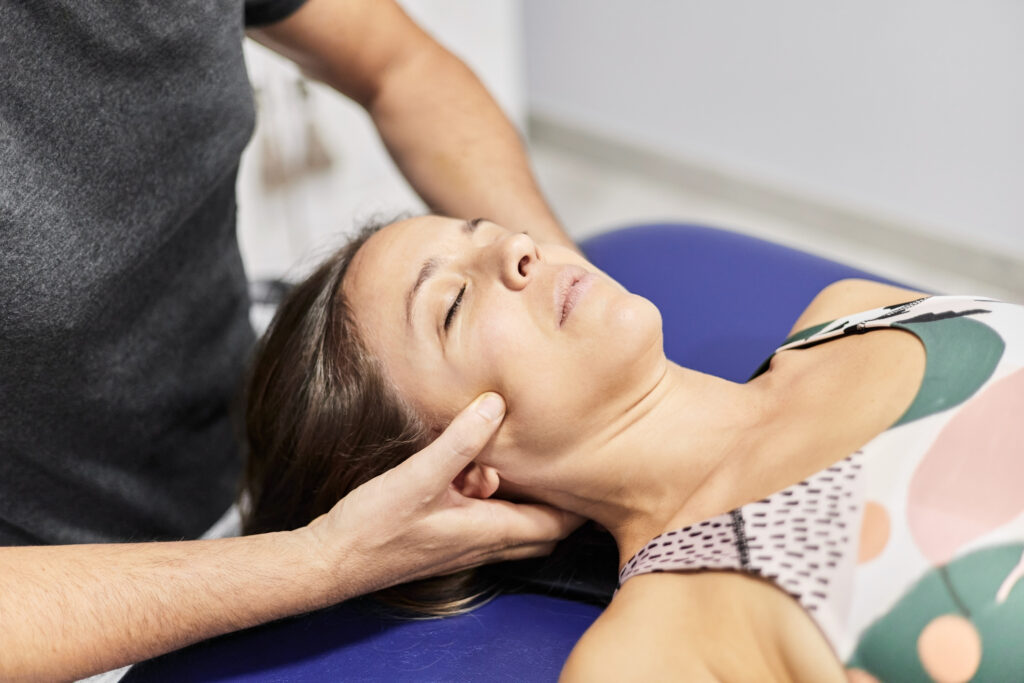What is TMJ?
TMJ stands for temporomandibular joint, and is the joint between the temporal bone in your skull and your jaw (mandible). A capsule protects the joint and also has synovial fluid to lubricate itself. Humans have a TMJ on each side of their jaw, and it’s the joint most responsible for opening and closing the mouth, chewing and moving the jaw side to side.
The sometimes-problematic part of the joint is a small articular joint. It works similarly to the meniscus in your knee, but it can be stressed or injured through impact or other degenerative conditions such as arthritis. When this joint doesn’t function correctly, it is known as temporomandibular joint dysfunction (TMD).

Signs you may need TMD treatment
If you notice any of the following symptoms, it’s probably a good sign that you should seek medical advice. TMD has many different symptoms and causes (which we’ll touch on next), so here are some signs to look out for.
- Clicking, grinding or popping of the jaw when opening and closing your mouth.
- Pain in the jaw, especially while chewing or speaking.
- Your jaw temporarily locks in an open position.
- Inability to open your mouth wide.
- Pain that also radiates to the neck, face, ears or back.
- Headaches and dizziness
If you notice any of these symptoms, you may be experiencing TMD, and it’s time to consult a medical professional.
What causes TMJ dysfunction (TMD)?
A range of factors could make a person susceptible to TMD, such as genetics, jaw injuries or arthritis. For this reason, it can often be difficult to pinpoint the source of the pain. Essentially, because the TMJ is a joint, dysfunction will occur under the following circumstances:
- The joint’s cartilage becomes damaged by arthritis
- An injury or blow to the jaw causes joint damage
- The disk erodes naturally and falls out of alignment
- You have poor posture, affecting your neck and spine
- Abnormal chewing habits causing undue stress on the joint
- Grinding or clenching your teeth over a long period of time
The list is quite broad, which is why it’s so crucial to speak to your doctor or physiotherapist for an accurate diagnosis.
TMJ physiotherapy – what’s involved?
When you book an appointment with MGS Physiotherapy to address your TMJ pain, it all starts with a thorough assessment, allowing us to devise a tailored treatment plan. A number of techniques can be used to treat your condition, but we don’t settle for simple pain relief. If there is an underlying source of your TMJ pain, we’ll address that too, ensuring a faster recovery with less likelihood of a recurrence.
Assessment
During your initial consultation, your physiotherapist will thoroughly assess your condition. This will likely involve questions about your overall health and fitness and manual tests to assess the source and severity of your pain. It’s important to be upfront with your physio, because the more information they have, the more accurate the diagnosis and the more effective the treatment plan will be. Following assessment, we can diagnose you and consider an appropriate treatment plan.
Tailored treatment plans
We don’t use one-size-fits-all treatments here at MGS Physiotherapy, because everybody is different. As we know, there can be many different causes of TMD, which means everybody’s treatment should be different. We tailor all of our treatment plans to ensure they are suitable for your specific injury or condition and recovery goals.
A few possible treatment methods include:
- Trigger point therapy and massage
- Dry needling
- Joint mobilisation
- Jaw strengthening exercises
- Posture correction
- Referrals to a dentist if required
You may not require all of these treatments, but your physio will put together a plan that provides the fastest and most long-lasting results.
Monitoring your condition
You might be wondering how long TMJ physio takes to have an effect. Unfortunately, everybody responds differently to treatment, but it’s likely that multiple sessions will be required. Your recovery goals often guide this, however, we will always prioritise a full, healthy recovery over a quick fix.
It’s important to monitor your condition while undertaking treatment, because your physiotherapist may be able to adjust your treatment plan depending on how you respond. During this monitoring period, your physio will likely give you some tips on avoiding TMD in the future. If you require a night splint, your physio may also refer you to a dentist.
Looking for TMJ physio near me?
MGS Physiotherapy offers specialist treatment for TMJ and other jaw-related conditions. We offer a range of treatment options completely tailored to your individual needs. You’ll find a warm, welcoming environment awaits you, making you feel comfortable in the hands of your trusted TMJ physio in Sydney. Don’t delay and put up with jaw pain any longer because MGS Physiotherapy is here to help. Book now at MGS Physiotherapy.
CALL NOW TO BOOK YOUR APPOINTMENT
